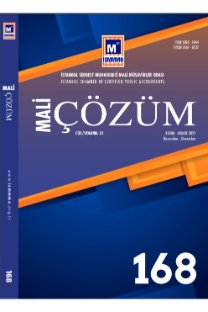Ufrs dipnot açıklama gerekliliklerine uyum: literatür araştırması
Bu çalışmada, UFRSnin dipnot açıklama gerekliliklerine uyum derecesi ve bu uyum derecesini etkileyen faktörlere ilişkin literatürdeki araştırmalar incelenmektedir. Yapılan araştırmalar, gelişmiş ülkelerde UFRSnin dipnot açıklama gerekliliklerine uyum derecesinin gelişmekte olan ülkelere göre daha yüksek olduğunu ortaya koymaktadır. Ayrıca, çalışmalar büyüklülük, karlılık, borçluluk durumu ve yaş gibi işletme özelliklerinin uyum derecesini etkilediğini göstermektedir. Ancak, bu faktörlerin uyum derecesini ne ölçüde etkilediğine ilişkin literatürde farklı sonuçlar mevcuttur.
Compliance with ifrs disclosure requirements: literature review
This study investigates the literature related to the compliance with in- ternational financial reporting standards (IFRSs) and the factors that affect the compliance level. Results of researches unveil a considerable extent of non-compliance in developing countries compared to developed countries. Furthermore, researches point out that level of compliance with IFRSs disc- losures is associated with some company characteristics, such as profitability, the level of leverage, company size and company age. However, the rese- arches showed mixed evidence on the effect of company characteristics on compliance level.
___
- Akhtaruddin M. (2005), Corporate Mandatory Disclosure Practices in Bangladesh, The International Journal of Accounting, 40(2005) : 399-422.
- Ali, Muhammad Jahangir, Ahmed Kamran, ve Henry Darren (2004), Disc- losure Compliance with National Accounting Standards by Listed Companies in South Asia, Accounting and Business Research, 34,3 (2004): 183-199.
- Alsaeed Khalid (2006), The Association between Firm-specific Charac- teristics and Disclosure: The case of Saudi Arabia, Managerial Accounting Journal, 21,5 (2006): 476-495.
- Al-Shammari, Bader, Philip Brown, ve Ann Tarca (2008), An Investiga- tion of Compliance with International Accounting Standards by Listed Com- panies in the Gulf Co-Operation Council Member States, The International Journal of Accounting, 43(2008) : 425-447.
- Al-Shammari, Bader (2011), Factors Influencing the Extent of Mandatory Compliance with International Financial Reporting Standards: The Case of Kuwaiti Listed Companies, Journal of International Business and Econo- mics, 11, 4 (2011) : 11-31.
- Cooke, T. E. (1989), Voluntary Corporate Disclosure by Swedish Com- panies, Journal of International Financial Management and Accounting, 1, 2 (1989) : 171-195.
- Demir Volkan, Bahadır Oğuzhan (2014), An Investigation of compliance with International Financial Reporting Standards by listed companies in Tur- key. Accounting and Management Information System, 13, 1 (2014) : 4-14.
- Dumontier, Pascal ve Bernard Raffournier (1998), Why Firms Comply Voluntarily with IAS: An Empirical Analysis with Swiss Data, Journal of International Financial Management and Accounting, 9, 3(1998): 216-245.
- Glaum, Martin ve Donna L. Street (2003), Compliance with the Disclosure Requirements of Germanys New Market: IAS Versus US GAAP, Journal of International Financial Management and Accounting, 14, 1 (2003): 64-100.
- Holthausen, R. W. ve R. W. Leftwich (1983), The Economic Consequences of Accounting Choice, Journal of Accounting & Economics, 5(1983) : 77-117.
- Hossain, Mohammed ve Helmi Hammami (2009), Voluntary Disclosu- re in the Annual Reports of an Emerging Country: The Case of Qatar, Ad- vances in Accounting, Incorporating Advances in International Accounting, 25(2009) : 255-265. http://www.fasb.org
- Jensen, M. ve W. Meckling (1976), Theory of the Firm: Managerial Be- havior, Agency Costs and Ownership Structure, Journal of Financial Eco- nomics, 3, 3 (1976) : 305-360.
- Juhmani, Omar I. H. (2012), Factors Influencing the Extent of Corporate Compliance with IFRSs: Evidence from Companies Listed in Bahrain Stock Exchange, Journal of International Business and Economics, 12, 2 (2012) : 67-79.
- Malone, D., C. Fries ve T. Jones. (1993), An Empirical Investigation of the Extent of Corporate Financial Disclosure in the Oil and Gas Industry, Journal of Accounting, Auditing & Finance, 8, 3(1993) : 249-273.
- Naser K. (1998), Comprehensiveness of Disclosure of non-financial Companies Listed on Amman Financial Market, International Journal of Commerce & Management, 2,8 (1998): 88-119.
- Owusu-Ansah, S. (1998), The Impact of Corporate Attributes on the Ex- tent of Mandatory Disclosure and Reporting by Listed Companies in Zimba- bwe, The International Journal of Accounting, 33,5 (1998): 605-631.
- Street, Donna L. ve S. J. Gray (2001), Observance of International Ac- counting Standards: Factors Explaining Non-compliance by Companies Re- ferring to the Use of IAS, ACCA Research Monograph.
- Street, Donna L. ve Stephanie M. Bryant (2000), Disclosure Level and Compliance with IASs: A Comparison of Companies with and without U.S. Listings and Filings, The International Journal of Accounting, 35, 3(2000) : 305-329
- Tower, G., P. Hancock ve Taplin, R. (1999), A regional study of listed companies compliance with international accounting standards, Accounting Forum, 23, 3(1999) : 293-305.
- Watts, R. and J. Zimmerman (1978), Towards a Positive Theory of the Determination of Accounting Standards, Accounting Review, 53,1 (1978): 112-134.
- ISSN: 1303-5444
- Yayın Aralığı: Yılda 6 Sayı
- Başlangıç: 1991
- Yayıncı: İstanbul Serbest Muhasebeci Mali Müşavirler Odası
Sayıdaki Diğer Makaleler
Mesleki tükenmişliğin muhasebe meslek mensuplarının etik tutumları üzerindeki etkisi
Ozan BÜYÜKYILMAZ, Serhan GÜRKAN
Yolsuzluk nedir? yolsuzluk çeşitleri ve ülkeler arası yolsuzluk algılaması
Ufrs dipnot açıklama gerekliliklerine uyum: literatür araştırması
Özlem ARABACI, Feriştah SÖNMEZ
Kaliteli finansal raporlamada denetimin rolü ile ilgili tartışmalar
Çağnur Kaytmaz BALSARI, Seçil VARAN
